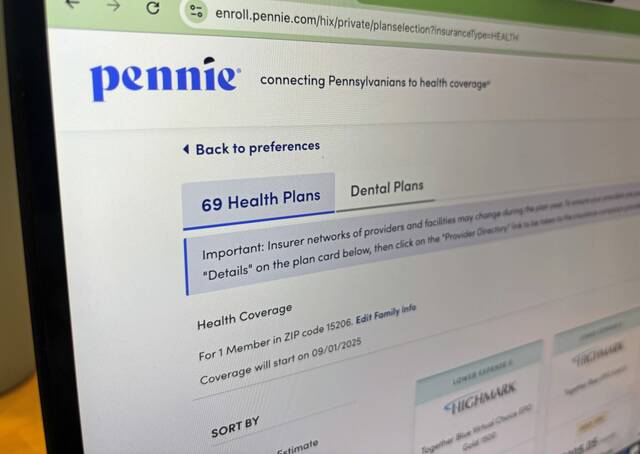5 things to know about Obamacare open enrollment
Steep discounts for millions of Americans on Obamacare won’t expire until Dec. 31, but an exodus from the government health insurance program is expected to start Saturday when open enrollment kicks off for 2026.
Nearly all people browsing Affordable Care Act plans will see higher prices than last year because of disappearing subsidies. In Pennsylvania, the average enrollee will pay 102% more in premiums to keep the same plan, according to Pennie, the state’s platform to shop for Obamacare.
Pennie also projects 450,000 of its 500,000 enrollees will face pricier premiums, with 150,000 of them leaving the exchange altogether. Many more might go for cheaper plans with weaker coverage.
It’s up to Congress whether the enhanced subsidies persist. Democratic leadership has made them a key demand in the shutdown fight, while their Republican counterparts wants to save the debate for after the government reopens. A deal before open enrollment looks unlikely.
Ahead of this critical date, here are answers to some key questions about Obamacare price hikes.
What are the enhanced subsidies?
The enhanced subsidies were established in the 2021 American Rescue Plan act to help more people purchase health insurance and access care during the pandemic. The Inflation Reduction Act of 2022 extended the program through 2025.
It built off a subsidy in the 2010 Affordable Care Act, which created a government-run marketplace for insurance, that helped people making up to four times the federal poverty level. In 2025, that’s just under $63,000.
The assistance can be claimed up front as a discount or later as a tax credit.
The enhanced version deepened subsidies under the income threshold and introduced a cost cap for everyone else that limited premiums to 8.5% of their earnings.
How much are premiums going up?
Pennie expects average premiums to more than double statewide, but it has also crunched the numbers on a county-by-county basis.
Allegheny and Westmoreland counties are slated for 75% and 46% increases, respectively.
Indiana County could be the hardest hit in the region, with an expected increase of 124%. That’s followed by Armstrong County’s 103% projected hike.
Juniata County, in Central Pennsylvania, is poised for a mind-boggling 485% rise in premiums.
Even if the subsidies went unchanged, the average cost of individual coverage on Pennie is set to climb about 22%, based on rates approved by the Pennsylvania Insurance Commission.
At the national level, more than 22 million subsidized enrollees will see an average premium increase of 114% next year, according to health policy nonprofit KFF.
Who will be impacted?
The Affordable Care Act marketplace can be used by anyone who’s in the country lawfully and whose other insurance options are considered unaffordable or inadequate. Medicare and Medicaid recipients are not eligible.
More than 24 million people across the U.S. have insurance through the program. This record enrollment was driven in large part because of the billions of dollars in additional subsidies.
Some 48% of those people work for a small business — about half of which don’t offer health insurance — or are self-employed. It’s also common for retirees who aren’t yet Medicare eligible to get Affordable Care Act coverage.
Are price hikes a done deal?
A health care compromise feels far off, but not impossible.
Republicans have floated several ways to keep enhanced subsidies, without just extending them as is.
These ideas include reintroducing a hard income cap, but at a higher level, as well as cutting off enhanced support for new enrollees and eliminating plans fully subsidized by taxpayers.
Rep. Brian Fitzpatrick, R-Bucks County, is sponsoring legislation that would extend the subsidies for a year, effectively kicking the can until after the 2026 elections.
If some kind of deal is reached, insurance officials with Pennie and other Obamacare marketplaces will have to scramble to update costs. The process normally takes Pennie about two months.
But even then, after Saturday, some people may have already selected coverage elsewhere.
How does enrollment work?
Pennie’s open enrollment period goes from Saturday, Nov. 1, to Jan. 15.
To get coverage starting New Year’s Day, however, the deadline is Dec. 15.
Open enrollment is the only chance to secure coverage through Pennie, except if an eligible life event arises, like job loss, marriage, divorce or the birth of a child.
Pennsylvanians who currently have Obamacare coverage should have received a price estimate from Pennie to keep their coverage. A cost calculator is also available on the Pennie website.
Jack Troy is a TribLive reporter covering business and health care. A Pittsburgh native, he joined the Trib in January 2024 after graduating from the University of Pittsburgh. He can be reached at
Remove the ads from your TribLIVE reading experience but still support the journalists who create the content with TribLIVE Ad-Free.

